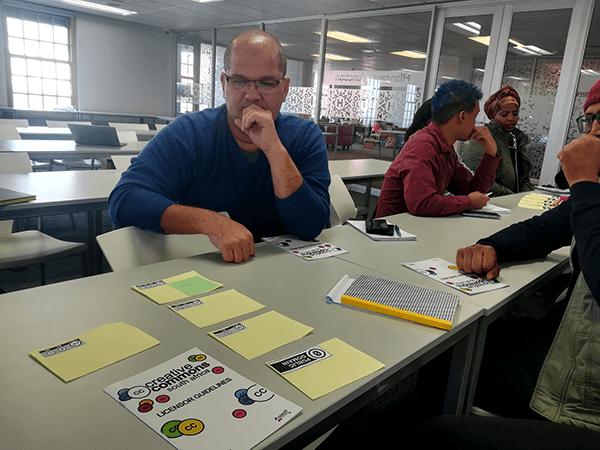Demystifying Creative Commons licences

On the 12 August 2019, a Creative Commons seminar was presented by Dr Glenda Cox from the Centre for Innovation in Learning and Teaching (CILT) at Hlanganani Junction. The event was hosted by UCT Libraries' Digital Library Services.

In photo: Dr Glenda Cox elaborating on the six Creative Commons licences at Hlanganani Junction.
Open Education at UCT
Over 10 years ago, the Open Education Movement at UCT began as a pioneering effort to make education more accessible. It started with a portal for Open Educational Resources (OER), where the academic community could share their teaching material online and with an open licence, said Cox.
The 2016 protests accelerated the push towards making teaching material available online while responding to the student call for localised curriculum. Online and blended learning environments were used to mitigate the loss of classroom time.
According to Cox, this introduced new challenges involving copyright when adapting internet resources such as images, videos and power point slides with course learning material. Since then, there has been a greater drive towards the responsible use of copyrighted works.
What is Creative Commons?
The Creative Commons (CC) is an international non-profit organisation with a network of affiliations, including South Africa. Cox explained that CC bridges the gap between Public Domain and Copyright material, by supporting owners who wish for their work to be used but with some restrictions. CC created six licences to facilitate the sharing and reuse of creative works and knowledge while protecting the rights of the owner.
How do we use Creative Commons licences?
From the comments in the room, it was clear that there was a need for clarity on how to interpret and use CC licences, without infringing on the rights of usage. Cox started by explaining the polar ends of the copyright scale, on the far left being work in the Public Domain (not copyrighted, "belongs to everyone"), and the far right, full copyrighted. "Everything put online is under full copyright by default", Cox added.
Six CC licences sit in the middle of this spectrum starting with the Creative Commons Attribution license (CC-BY) - the most open licence and used by OER at UCT. This licence only requires that the original creator is given credit using an attribution.
The six CC Licences
Design: Markus Büsges, leomaria designbüro, Germany [CC BY-SA 4.0], via Wikimedia Commons
How to create a CC licence
Visit the CC website for a step-by-step guide for licensing your work, and to help you choose the appropriate licence. Ready-made CC logos are included with the embed code to insert into any website.
Workshop Exercise

In photo: CC licences get a bit fuzzy during group work as attendees get to work.
Armed with new CC knowledge, the attendees were split into groups towards the end of the session. They were tasked with creating a new learning resource from five CC licenced internet resources (represented by cards). This new resource had to be licenced while respecting the licence of the individual resources used.
Cox ended the session with some best practices for material attribution, and interesting ways to find CC licenced material online.
Best Practice for Attribution in OER
- Give credit to people who helped put together an OER resource collaboratively. Be upfront and acknowledge who was involved.
- Attribute how each resource can be used according to their CC licence.
- Visit the CC website for more information on attribution for images, videos and other resources.
How to find CC licenced material
- Search the Creative Commons to find CC licenced material.
- Filter by collection to find websites with CC licenced material such as Flickr, YouTube and Jamendo.
For CC support and questions
Creative Commons FAQs
University of Cape Town
Dr Glenda Cox or Thomas King from CILT
Intellectual Property (IP) Unit
